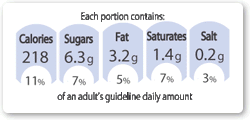The information on this page is historical. Food labels are changing and the term Guideline Daily Amount is being replaced by Reference Intake (RI). Read about the new nutrition labelling requirements.
FLABEL research into food labelling
In January 2012 an EU-funded research consortium, Food Labelling to Advance
Better Education for Life (FLABEL), published the results of three years of
research
to establish the role of food packaging labels and identify what can be
achieved
when communicating nutrition information to consumers via these labels.
The results of this state-of-the-art research project show that despite good
understanding and prevalence of nutrition information on food labels in Europe,
a
lack of motivation and attention of consumers prevents labels from impacting
positively on food choices.
- The main findings of the research: Food Labelling to Advance Better Education for Life
EUFIC research on portion information on labels
A recent pan European study conducted in collaboration with the University of
Surrey surveyed 13,117 consumers and focused on how consumers respond to
portion
information on food and drink labels. The initial results of the research show
that when portion information is present on pack in addition to per 100g/100ml
information, consumers can use it to help them to use nutrition information
correctly.
The researchers note that although there is an opportunity to
educate
consumers on what constitutes a portion and how they are set, the challenge
remains to
encourage consumers to look for and use the information.
- Summary of findings on EUFIC website (February 2011)
- EUFIC Webinar: How do Consumers Respond to Portion Information on Food and Drink Labels? (February 2011)
FSAI research
In December 2009 the Irish Food Safety Authority published a new research study
that looks into Consumer’s attitudes to food labelling. Among the results, it
emerges that 87% of consumers consider the nutrition table on a label to be
very
or fairly important, but most would prefer to see nutrient values stated per
portion (e.g. per bowl), than per 100 g or 100 ml; 53% of the respondents
preferred
a GDA label.
- Full research: A Research Study into Consumers’ Attitudes to Food Labelling (December 2009) – pdf | 176kb
Impact of front-of-pack ‘traffic light’ nutrition
labelling on consumer food purchases in the UK
This study examined changes to consumer food purchases after the introduction of
traffic-light labels with the aim of assessing the impact of the labels on the
‘healthiness’ of foods purchased. The study examined sales data from a major UK
retailer in 2007.
Critically, there was no association between changes in product sales and the
healthiness of the products. The authors recommend that further research on the
influence of nutrition signposting is needed before this labelling format can
be
considered a promising public health intervention.
- Abstract: Impact of front-of-pack ‘traffic-light’ nutrition labelling on consumer food
purchases in the UK – This was published online October 2009 by Oxford University Press
FLABEL research on Nutrition labelling
In April 2009 the EU Project FLABEL published the first part of its research. On
average 85% of the products audited contained nutrition information on the back
of pack and front-of-pack nutrition information was found on average on 48% of
all products, reaching as high as 82% in the UK.Guideline Daily Amounts (GDA)
were on average on 25% of products with a peak of 63% in the UK. Nutrition
claims
and GDAs were the most prevalent forms of nutrition information on the
front-of-pack.
- Summary of results: FLABEL News Overview (Published April 2009)
EFSA scientific opinion
European Food Safety Authority (EFSA) scientific opinion on the review of
labelling reference intake values for
selected nutritional elements.
Following a request from the European Commission, EFSA’s panel on Dietetic
products, Nutrition and Allergies (NDA) was asked to review and provide advice
on
labelling reference intakes for energy, fat, saturated fat, carbohydrates,
sugars
and salt as included in the food information proposal.
Their conclusions back the values currently used by the food industry.
- Full EFSA opinion: Review of labelling reference intake values – (2009)
Mirror readers survey
GDA labelling survey conducted by the Mirror newspaper group. The research
carried out in December 2007 / January 2008 showed that 90% of mirror readers
were aware of GDA
labels
and 85% found them easy to understand.
The research showed that consumers use the GDA information to understand how
healthy a product is and to help them choose products that make up a balanced
diet.
- Summary: GDA Mirror Group Survey – (2007/08) – pdf | 311kb
- Download full survey: GDA Mirror Group Survey – (2007/08) – pdf | 66.3kb
EUFIC research
A pan-European study by the European Food Information Council (EUFIC). The
research questioned some 17,300 people in France, Germany, Hungary, Poland,
Sweden
and the UK, both in supermarkets and at home and found that on average only
18%
of Europeans (ranging from 27% in UK to 9% in France) regularly look for
nutrition
information on food packaging in store.
The UK-specific part of this study, conducted in 2008, was published on-line in
the peer-reviewed Journal ‘Appetite’ in May 2010. The study found that more
than
65% of UK consumers look at front of pack labels, with most consumers having a
good understanding of GDAs. The research concluded that although UK consumers
were exposed to basic nutrition information on food labels and understood them,
they did not have the motivation to use them.
- Full paper published in the Journal of Appetite: Nutrition knowledge, and use and understanding of nutrition information on food
labels among consumers in the UK (May 2010) – pdf | 1.97Mb - Full paper published in the Journal of Public Health: Use and understanding of nutrition information on food labels in six European
countries (January 2010) – pdf | 400kb - EUFIC research: executive summary – (2008) – pdf | 411kb
- Download full research: presentation results – (2008) – pdf | 3.64Mb
- Download: methodology – (2008) – pdf | 71.6kb
Millward Brown research
In 2008 the Food and Drink Federation commissioned a research study in order to
track
awareness, understanding, usage and influence of GDA labelling in the UK.
The latest research shows the number of consumers now aware of the GDA
front-of-pack nutrition-labelling scheme has risen from 70% in Oct 2006 to 83%
in April
2008 and the number of consumers who have already used them has risen from 49%
to
63% over the same time period.
In addition, 80% of people say they find the labels easy to understand and 84%
would like to see GDA labels on even more packs.
The survey results covers the period October 2006 to September 2008.
- Download summary: How has awareness, comprehension and
usage of GDA labelling evolved?
– (2008) – pdf | 1.01Mb
Last reviewed: 27 Feb 2014

Example GDA label
Today's poll
FSA’s salt campaign uses GDA figures

Did you know?
GDAs were developed in the late 1990s by a group of experts based on COMA
medical report – see GDAs explained for more.
